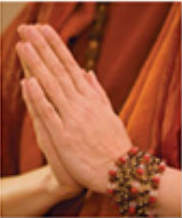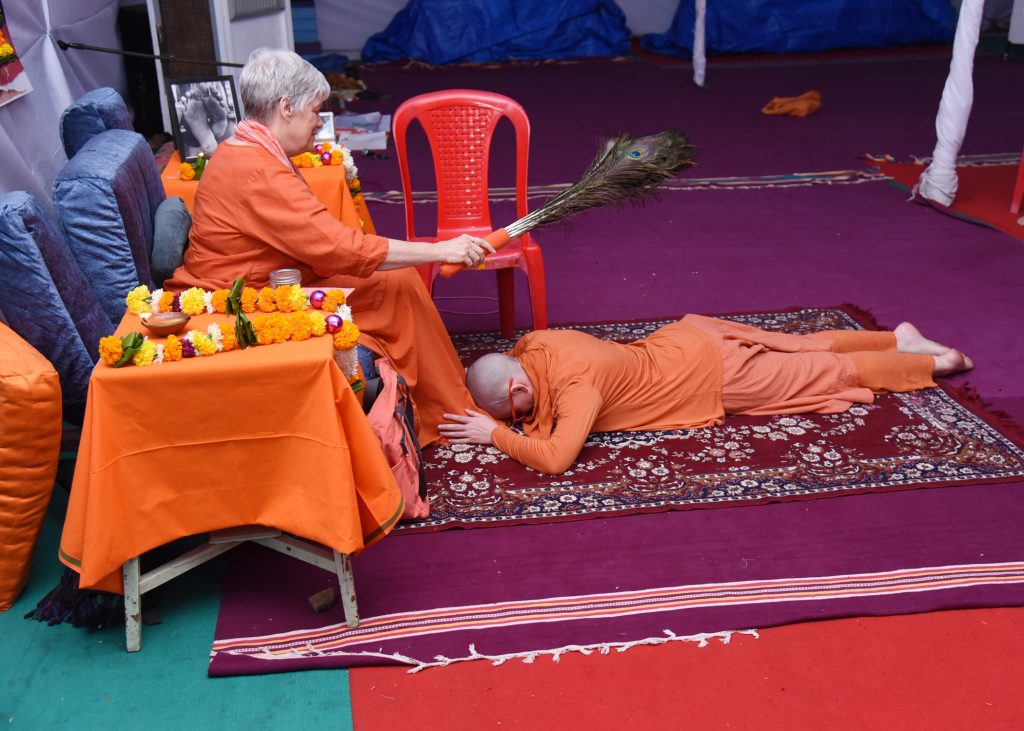
By Swami Satrupananda
Many yoga classes end with bringing your hands together in anjali mudra (prayer pose). You may bow your head to the teacher and say, “Namaste.” Meditation programs with a Meditation Master might offer an opportunity to bow to them. Yoga is about knowing who you really are. It’s about you. So why do you bow to others?
Let’s step back and look at bowing around the world. I was introduced to bowing in church. Built into the pews were kneelers. Part way through the service, we would kneel, bow our heads and say a prayer. At an international conference, I was exchanging my business card with a gentleman from Japan. He held his business cards with both hands, bowed his head and handed one to me. Recently, I watched a video of the very popular Korean music group BTS. One of the group members spotted his parents in the crowd at a stadium performance. He immediately bowed down, fully prostrated, to his parents in front of thousands of fans. In many Eastern countries, children bow to their parents.
In the East, bowing is interwoven into their everyday life. In the West, we might bow at church. But in our day-to-day lives, bowing is not as popular. It is perceived as being submissive, inferior, and subservient. This is part of the definition of bowing. Yet bowing also means to lower your head or upper body as a sign of respect. The businessman was showing respect as he presented his business card, not submission. The BTS band member was showing gratitude for his parents, not subservience.
With the popular namaste greeting, bowing is gaining a better reputation in the West. During the pandemic, a news article recommended namaste as a replacement for shaking hands. While bowing may be weaving into our culture, why is bowing part of yoga? It’s the expression of respect and gratitude that is important. In yoga class, your teacher says “namaste” as an expression of respect for you. When you respond with “namaste,” you are expressing your gratitude. And yet it is more than gratitude. In my Yoga Teacher Training, this definition of namaste was shared:

I honor the place in you in which the entire universe dwells. I honor the place in you which is of love, of truth, of light, and of peace. When you are in that place in you, and I am in that place in me. We are one.
When you say “namaste,” you are cultivating your ability to be in that place. That place in you is where you are the One. That place is the source of love, truth, light, and peace. And from that place in you, you see the same One, being everyone and everything. There is only One here. How do you get to know yourself as the One? By bowing. Namaste literally means “bow to you.” Bowing is an act of honoring.
You are what you honor. If you honor education, you’ll go to school and earn a degree. You become educated. If you honor family, you’ll spend lots of time with them, create family traditions and memories. You’ll be a family man or woman. If you honor a sport, you’ll know all about it. You’ll play it or watch a lot of it on TV. You’ll wear sporting gear or a shirt with your favorite team’s logo. You’ll be a sports person. You are what you honor.
Yoga says to honor the One that you are so that you become that One. My Guru’s Guru described it this way, “When bow, you become one with that to which you are bowing.”
With the namaste greeting, you are bowing to the other person. Does that you mean that you become the other person? No. You are bowing to the One that is being the other person, while being you. This can get tricky when you are bowing to unenlightened beings. The not-knowing of their own One-ness blocks the light of the One shining through them. In contrast, when you bow to someone who knows their own One-ness and they see that One-ness in you, something different happens.
This has been my experience. Every time I bow to my Guru, Gurudevi Nirmalananda, I have an experience of my own One-ness. One day as I bowed to her, I had an inner vision of our universe. I was the whole universe and the whole universe was inside me. As I continued to surrender in my bow, my being expanded. I am not merely the universe; I am the infinity that includes the universe and beyond. I am the infinite One-ness. All of this from a bow.

When you bow to an Enlightened Being, they know their One-ness. They also see that same One in you. The One is being both the person bowing and the person being bowed to. The One is being the two honoring the One. That is the mystical play of bowing. Every time you bow, you play in that mystical non-dual duality. And when you bow to an Enlightened Being, they enliven that play. So you can know that you are the One bowing and the One being bowed to.